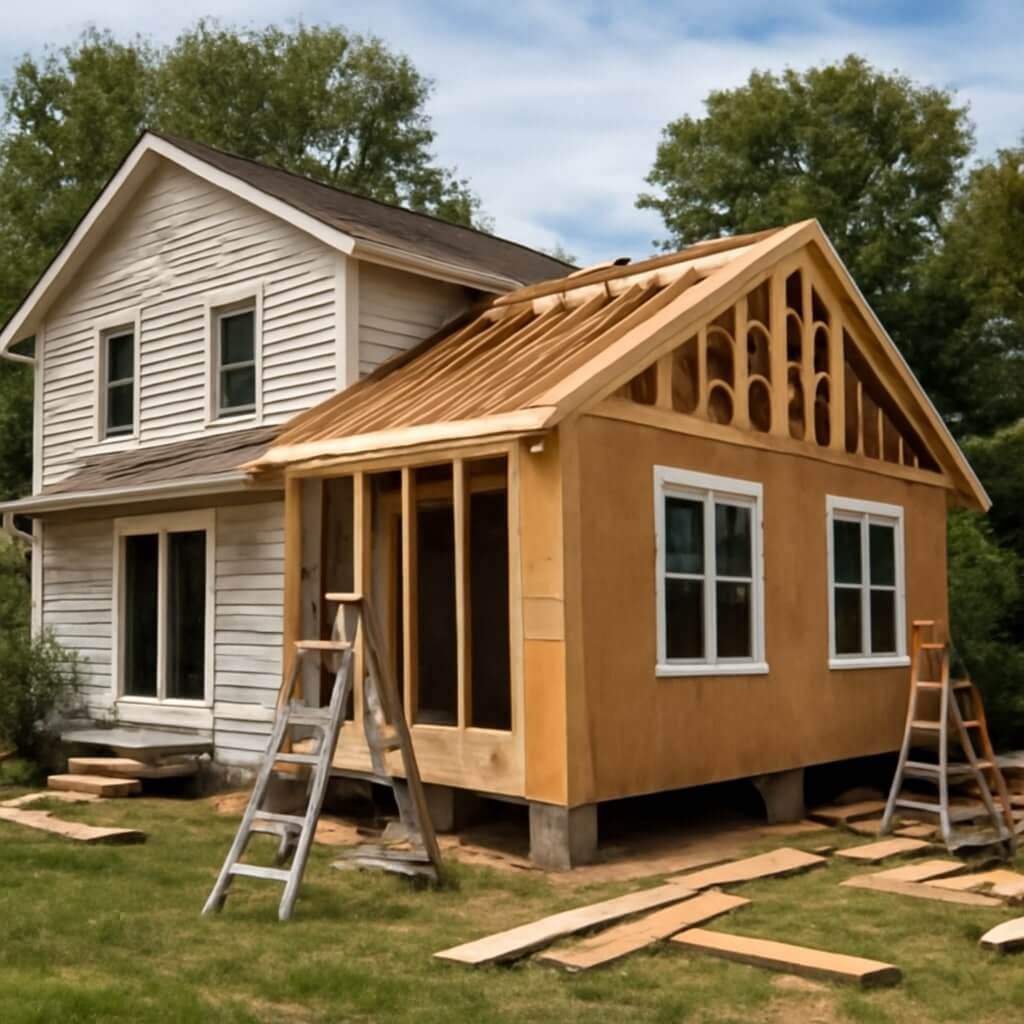Planning a home addition in Canaan can be a rewarding yet complex endeavor. You need to navigate local building codes, set a realistic budget, and determine the true purpose of your addition. Each choice impacts not just your current living space but also its future value. Before you jump in, consider these essential tips that can streamline the process and help you avoid common pitfalls. Let’s explore what you should keep in mind.
Key Takeaways
- Research local zoning laws and permit requirements to ensure compliance before starting your home addition project in Canaan.
- Establish a detailed budget that includes a contingency fund for unexpected expenses during the addition process.
- Clearly define the purpose of your addition to guide design choices and ensure it meets your family’s needs.
- Maintain architectural consistency by using similar materials and design elements to blend the addition with your existing home.
- Plan construction during non-disruptive hours and communicate with neighbors to minimize disturbances during the project.
Understand Local Building Codes and Regulations
Before diving into your home addition project, it’s essential to grasp the local building codes and regulations that govern construction in your area.
Familiarize yourself with zoning laws, as they dictate what you can build based on your property’s classification. Check for permit requirements, as most localities mandate permits for structural changes.
Ignoring these regulations can lead to fines or forced removal of your addition. Consult your local building department or a professional to guarantee compliance and avoid costly delays.
Set a Realistic Budget
Setting a realistic budget is essential for the success of your home addition project, especially since unexpected costs can quickly derail your plans.
To help you with effective budgeting strategies, consider these steps for accurate cost estimation:
- Research market rates for materials and labor.
- Include a contingency fund of 10-20% for unforeseen expenses.
- Break down your budget by specific tasks, like permits, labor, and materials.
- Consult with professionals to validate your estimates and gather insights.
Determine the Purpose of Your Addition
Understanding the purpose of your addition can greatly influence both the design and functionality of your space. Whether you need a home office, an extra bedroom, or a family room, identifying your goals is key. Different addition types will cater to specific space requirements, so clarify your needs early in the planning process.
| Addition Type | Purpose | Space Requirements |
|---|---|---|
| Home Office | Work productivity | 100-200 sq ft |
| Extra Bedroom | Guest accommodation | 150-250 sq ft |
| Family Room | Entertainment | 200-400 sq ft |
Consider Architectural Consistency
As you commence planning your home addition, it’s crucial to reflect on architectural consistency to guarantee your new space harmonizes with the existing structure.
Achieving design harmony enhances your home’s appeal and value. Here are some tips to ponder:
- Identify Architectural Styles: Research your home’s existing style to maintain continuity.
- Use Similar Materials: Choose siding, roofing, and windows that reflect the original design.
- Match Proportions: Confirm the addition’s size complements the main structure.
- Incorporate Design Elements: Mimic details like moldings, trim, and color schemes to create unity.
Hire the Right Contractors
With a well-planned addition that maintains architectural consistency, the next step is to hire the right contractors to bring your vision to life.
Start by identifying contractor qualifications that align with your project’s needs. Look for licensed professionals with experience in similar additions.
Identify contractors with relevant qualifications and licensing to ensure they can effectively handle your addition project.
Begin the vetting process by gathering recommendations, checking online reviews, and reviewing portfolios.
Schedule interviews to assess their communication skills and approach to problem-solving. Don’t forget to request detailed estimates and timelines.
A thorough vetting process guarantees you choose skilled contractors who understand your vision and can execute it efficiently, minimizing potential hiccups along the way.
Plan for Disruption and Temporary Living Arrangements
When you commence on a home addition, be prepared for the inevitable noise and dust that can disrupt your daily life.
Consider your temporary housing options, whether it’s staying with family or renting a nearby space, to maintain your comfort during the construction phase.
It’s also wise to communicate with your neighbors about the upcoming changes, as keeping them informed fosters goodwill and understanding.
Anticipate Noise and Dust
Planning a home addition can be exciting, but it also means bracing yourself for the inevitable noise and dust that come with construction.
To minimize disruption, consider these essential strategies:
- Schedule Work Wisely: Plan construction during hours that won’t interfere with your daily routine.
- Implement Noise Reduction: Use soundproofing materials to dampen the clamor from machinery.
- Practice Dust Management: Seal off construction areas to contain dust and maintain air quality.
- Prepare Your Space: Clear out rooms near the worksite to reduce clutter and make cleaning easier.
Temporary Housing Options
How will you cope if the noise and dust of construction become overwhelming? Exploring temporary housing options might be your best bet. Consider short-term rentals that cater to your needs, ensuring you’ve got a comfortable space during the upheaval. When reviewing rental agreements, focus on flexibility and duration to avoid complications. Here’s a quick comparison of popular options:
| Option | Pros |
|---|---|
| Vacation Rentals | Fully furnished |
| Extended Stay Hotels | Services included |
| Sublets | Often more affordable |
| Corporate Housing | Spacious for families |
| House Sitting | Cost-effective |
Each choice has its unique benefits, so choose wisely!
Communicate With Neighbors
While maneuvering through the challenges of home additions, keeping your neighbors informed can make a significant difference in how smoothly the process unfolds.
Here are some essential steps to contemplate:
- Host neighborhood meetings to present your plans and timelines.
- Encourage community feedback to address concerns and suggestions.
- Notify neighbors about potential disruptions, such as noise or parking issues.
- Offer temporary living arrangements or solutions if their daily routines are affected.
Keep Future Resale Value in Mind
When planning your home addition, it’s essential to take into account how your enhancements will align with current market trends and neighborhood standards.
Think about what potential buyers are looking for in your area—upgrades that appeal to them can greatly boost your home’s resale value.
Market Trends Analysis
As you consider planning your home addition, it’s essential to analyze current market trends to guarantee your investment pays off in the long run.
Pay attention to the following factors:
- Market Demand: Understand what buyers are looking for in your area.
- Design Preferences: Research popular styles and materials to appeal to potential buyers.
- Property Size: Consider how your addition affects the overall square footage; larger homes often fetch higher prices.
- Energy Efficiency: Eco-friendly features are increasingly attractive, improving resale value.
Neighborhood Comparisons
Understanding the dynamics of your neighborhood is crucial for maximizing the future resale value of your home addition. Analyze neighborhood amenities—parks, schools, and shopping options—that considerably impact property values.
If your additions align with local trends, like adding a home office or an outdoor living space, you’ll attract potential buyers. Compare your home with similar properties nearby to gauge what’s acceptable and appealing.
Ascertain your enhancements don’t exceed the neighborhood standards, as over-improvements can lead to diminished returns. Ultimately, thoughtful planning based on neighborhood comparisons will help you create a space that enhances both your living experience and future resale potential.
Conclusion
By following these essential tips, you can navigate the complexities of planning your home addition in Canaan with confidence. Staying informed about local regulations, budgeting wisely, and maintaining architectural harmony will not only enhance your living space but also safeguard your investment. Remember to reflect on the needs of your family and the potential impact on resale value. With careful planning and the right professionals by your side, you’ll create a seamless addition that complements your home beautifully.

